Lens Battle: Tamron 70-180mm f/2.8 vs Canon EF 70-200mm f/2.8L IS II
![]()
The non-photographers might want to skip this article as it is a fairly detailed Tamron 70-180mm f/2.8 Di III VXD vs Canon EF 70-200mm f/2.8L IS II USM lens review for Sony E-mount cameras.
I know many people that have switched to Sony over the last few years from Canon who have held onto some of their Canon lenses to use with an adapter. With the Sony 70-200mm f/2.8 currently costing $2,600, quite a few I know have held onto their Canon 70-200mm f/2.8 lens, put off by the huge cost of the Sony equivalent. This was definitely the case for me.
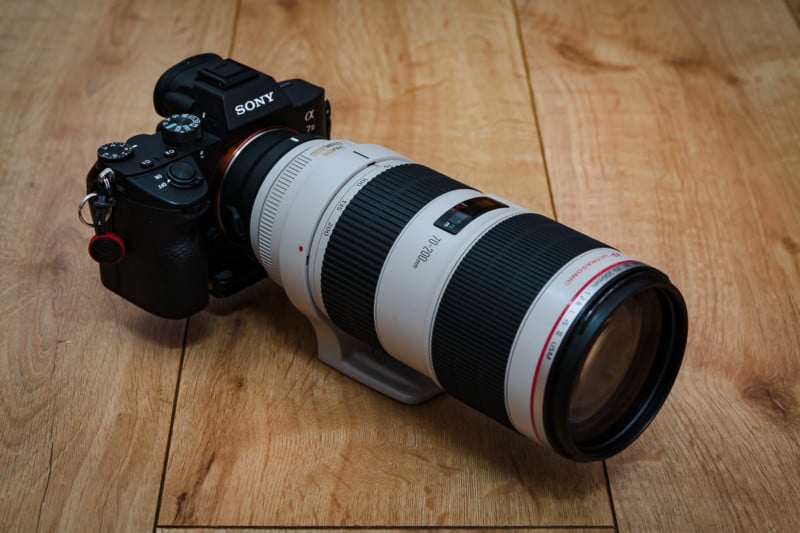
I’ve been using the Canon EF 70-200mm f/2.8L IS II USM with the Sigma MC-11 adapter on my Sony a7 III for the last 2 years. Although the lens performs great and is as sharp as a tack, there are a few issues that have caused me problems here and there. The biggest of these being the occasional lockup which can only be fixed by turning the camera off and pulling the battery out, not ideal if you’re shooting a one-off event like a wedding.

I’ve just received my own Tamron 70-180mm and thought it would be interesting to do a review specifically comparing it against the Canon 70-200mm to decide if is it worth the switch. I’ll compare both lenses across a range of parameters to see which comes out on top.
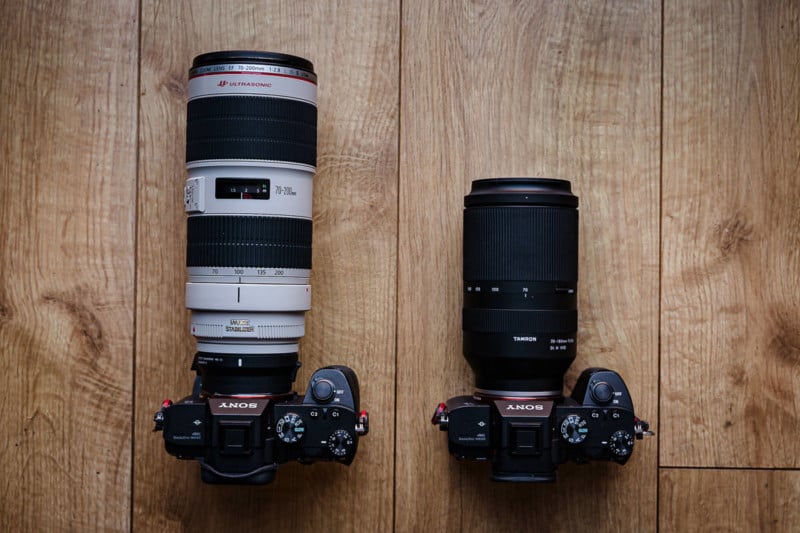
Having already bought and been hugely impressed with the E-mount Tamron 28-75mm f/2.8 Di III RXD and the Tamron 17-28mm f/2.8 Di III RXD zooms I was keen to see how Tamron’s longer focal length zoom would perform.
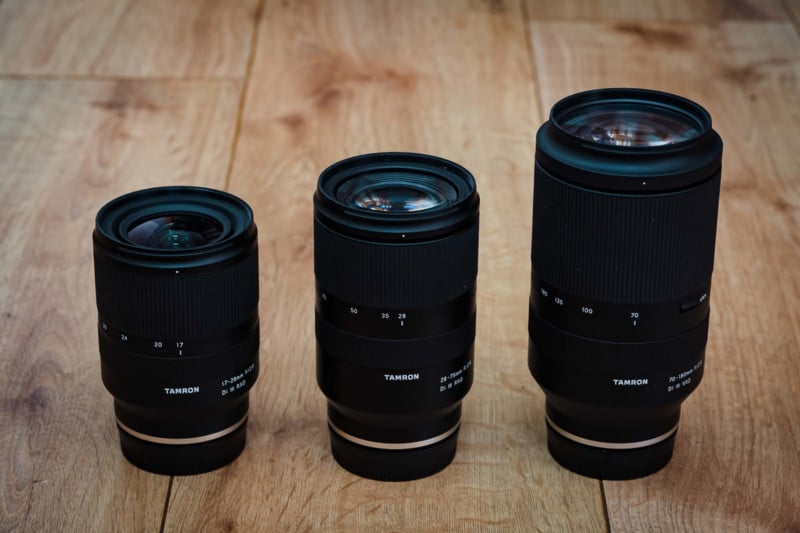
The current Tamron zooms that I have offer excellent image quality at a much more affordable price than the native Sony equivalents. I’m mainly a prime lens shooter but do like a set of zooms for backup use and for when I need that extra bit of flexibility. Being as I mainly shoot primes I don’t want to be spending a fortune on my zoom lenses. This is one of the main reasons I’ve been drawn to the Tamron range rather than the Sony equivalents.
The Tamron total for the three lenses is $2,977, and the Sony total is $6,994. The three Tamron lenses are less than half the price of the Sony equivalents, the saving of $4,017 is hard to ignore.
Testing
Note: For these tests, I’m using the Canon EF 70-200mm f/2.8L IS II USM with a Sigma MC-11 adapter on the Sony a7 III body, all loaded with the latest firmware as of June 2020. Your performance may vary depending upon adapter, body, and firmware versions. The images were processed using Adobe Lightroom Classic release 9.3.
Doing back-to-back comparisons has proved more difficult than expected. Despite having a fairly robust tripod (Manfrotto 190) and a heavy-duty ball-head (Sirui K-40X) it was impossible to change lenses without the weight difference between the two setups to cause the tripod to shift position slightly.
Despite everything being locked down and all the adjusters on the ball head being fully tightened as far as they could go, the tripod would still ease forward slightly due to the Canon 70-200mm being so much heavier than the Tamron 70-180mm. This would cause the field of view to alter. The only way to compensate for this was to adjust the tripod slightly between setups, this is not ideal as it’s difficult to get everything lined up exactly, especially with long focal lengths where even the smallest change at the camera can have an impact on the view.
Zoom Range / Field of View
Before the Tamron 70-180mm f/2.8 Di III VXD was even available, there were plenty of people online ranting that they would never get it as it only zooms to 180mm rather than 200mm. When comparing wide-angle lenses, a few mm difference in focal length can make a big difference in the field of view. However, the effect is diminished as the focal length increases. One of the first things I wanted to test was to see just how much of an effect the loss of 20mm at the long end of the zoom range really has.
The following shots were taken with the help of my daughter, who sat as still as a five-year-old can (which is not very still) so that I had a human target. Both lenses were shot wide open at f/2.8 and focused on the face using eye AF. Upon import into Lightroom, I applied my standard preset and also tuned on the lens corrections to remove any distortion and vignetting. To make the comparison of field of view easier the images were combined into GIFs. However, this does reduce the quality a little. This first shot is with both lenses at their maximum zoom range.

As expected, we can see that there’s definitely a difference with the Canon showing a slightly tighter crop. Is it enough to completely dismiss the lens? No, not for me. If you do need a 200mm equivalent field of view with the Tamron, with today’s high-resolution sensors, the loss of a few megapixels of data when cropping shouldn’t be an issue for most people.
For the next image, the Canon 70-200mm was set to 180mm to check how the field of view compared to the Tamron at 180mm.

The field of view is almost the same, some of the difference seen is due to the movement of the tripod mentioned earlier.
Without moving the camera I also racked the zoom on both lenses all the way back to 70mm to see if there were any differences at the wide end.

Despite both lenses being listed as 70mm at the wide end, there’s a noticeable difference with the Tamron having a wider field of view than the Canon. I tried to adjust the zoom on the Tamron to give the same field of view as the Canon at 70mm. I couldn’t get an exact field of view match, it’s a little tricky when using a slightly restless/bored 5-year-old! The closest that I managed was with the Tamron at 75mm and the Canon at 70mm.

At 75mm the Tamron is a little tighter than the Canon at 70mm, showing that the matching focal length is probably 74mm (I couldn’t get this exact focal length set!).
And the winner is… A marginal win for the Canon. Although the Tamron is about 4mm wider than the Canon it’s 20mm shorter at the long end. Taking the Tamron as 70-180mm gives a zoom value of 2.6. If the Canon as 74 to 200 then that gives it a slightly longer zoom range of 2.7.
Sharpness
One of the ways that I evaluated sharpness in the past was by using the rather brilliant Focal software from Rikan. This is an automated test tool that gives an empirical measurement of lens performance/sharpness. Unfortunately, the software doesn’t support Sony cameras so I’ll have to make a more objective visual assessment.
I’ve made a side by side comparison of the images used in the field of view tests above. Zooming in at 2:1 and viewing on a 4k display. In the images below, the Canon file is always on the left and the Tamron file on the right. The first image shows the 2:1 comparison at the wide end with both lenses at 70mm.
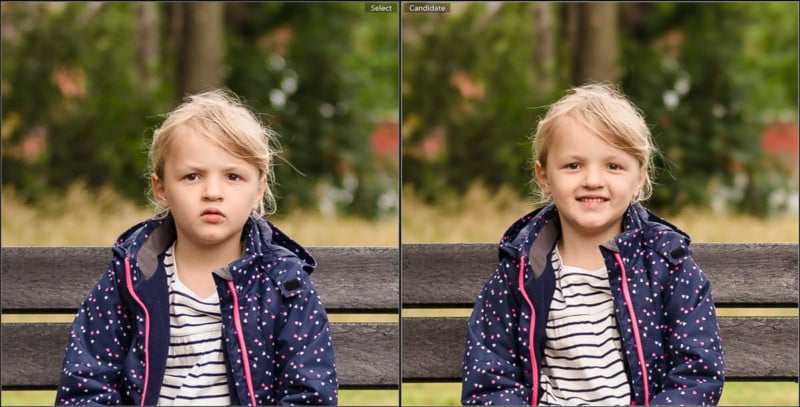
Even when looking at the original files in Lightroom (not the web compressed versions you’re seeing here) I really can’t see any meaningful difference in sharpness between the two lenses.
This was also repeated with both lenses at their maximum reach — 200mm for the Canon and 180mm for the Tamron (hence the slight difference in size of the 2:1 crop below).
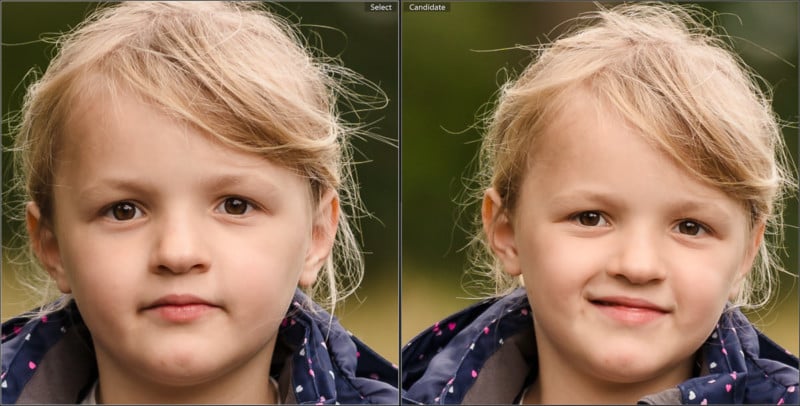
Again, I really can’t see any meaningful difference in sharpness, the Tamron is equally as sharp as the Canon.
And the winner is… using my completely unscientific/uncalibrated eye I score this a draw, both appear as sharp as each other.
Bokeh
How the lens renders the out of focus areas is also really important. The in-focus areas need to be sharp with smooth out of focus areas desirable in order to give nice separation of the subject from the background. I want the bokeh to be as free from detail as possible so that the eye is drawn to the subject.
I again used the images from the field of view tests, but this time examining the out of focus background. This first image is from the 70mm wide end of both lenses, again the Canon image is on the left and the Tamron on the right, the crop is at 3:1.
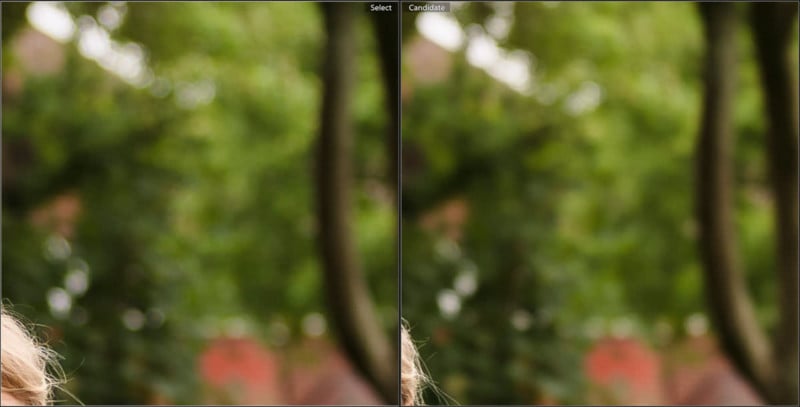
I’m not seeing a massive difference, the bokeh is a little bigger in the image from the Canon lens but this is due to the Canon not being as wide as the Tamron (even though they both are listed as 70mm at the wide end). To try and even things up a little I also compared a 3:1 crop of the Canon at 70mm and the Tamron at 75mm, this is shown in the next image.
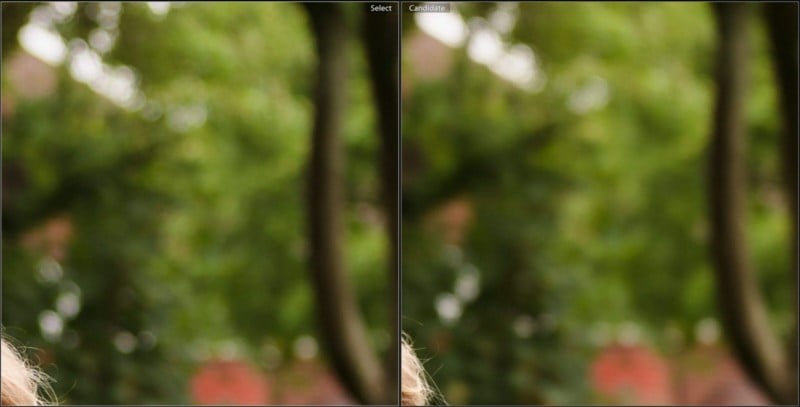
To me, there’s not a massive difference in quality here. There may be a little more detail/contrast in the left-hand-side image from the Canon and the Tamron looks a fraction smoother (it’s very marginal though to my eyes). This gives a very slight advantage to the Tamron.
The same comparison was repeated with both lenses at their maximum range — 200mm for the Canon and 180mm for the Tamron. The 2:1 crop is shown below.
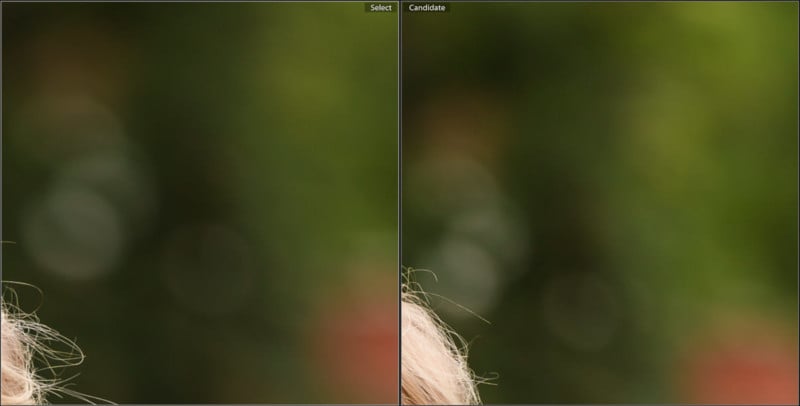
As with the wide-angle comparison, there is an obvious difference in the size of the bokeh due to the different focal lengths. Another crop was taken, this time from the images with both lenses at a matching 180mm.
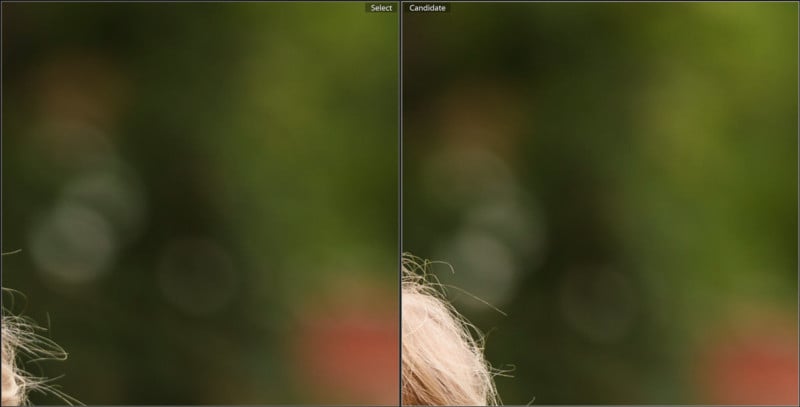
As with the wide-angle comparison, I feel there’s a little more detail/contrast in the out of focus areas of the Canon and the Tamron is a slight fraction smoother.
And the winner is… again using my unscientific/uncalibrated eye it’s a slight win for the Tamron
Vignetting and Distortion
My understanding of optics is that vignetting and distortion are usually worse at wider focal lengths. So to keep this already lengthy post shorter, I’ll compare the vignetting and distortion at 70mm only. Once again, and for the final time, I’ll use the same images as used on the field of view, sharpness, and bokeh tests. First up is the Canon 70-200mm at 70mm and f/2.8 followed by the Tamon with the same settings.


As expected, both of the lenses are subject to vignetting and distortion which is easily visible in the overlay images. From my assessment, it looks like the distortion is slightly worse on the Canon and vignetting slightly worse on the Tamron.
In the real world, this level of vignetting and distortion is not really a problem as Lightroom has the lens profiles to automatically correct these issues. The only time the vignetting correction can be a problem is if you excessively push the exposure of your images during post-processing, this can lead to an increase in the noise or some false color in the corners (which can be remedied by applying a slight vignette!).
I’m not sure if this happens with all lens mount adapters on the Sony a7 III, but with the Sigma MC-11 Lightroom doesn’t automatically recognize the adapted lens type. This means that it can’t automatically apply the relevant corrections, meaning they have to be manually selected. This slows down the editing process. This shouldn’t be an issue if you’re only editing files with this one lens or if you’re only editing a few files. But if you’re shooting something like a wedding with lots of lens changes and hundreds of files to edit then it can become a bit of an annoyance.
And the winner is… A marginal win for the Tamron due to the fact that Lightroom automatically recognizes the profile corrections.
Autofocus
When I originally switched from the Canon 5D Mark IV to the Sony a7 III one of the main features that drew me over was the insane autofocus performance of the Sony cameras, I felt that the face and eye AF were game-changing technology. However, one of the drawbacks of using an adapted lens is that the face tracking/eye AF doesn’t cover the same viewfinder area as native Sony glass.
In the vertical direction, the coverage is roughly the same, with adapted and native lenses both allowing the AF system to work all the way from the top to the bottom of the frame. However, there is a significant difference across the horizontal axis as you move from the center of the frame out to the edge.
To find out the range of the AF system I did some tests to map out the areas where repeatable AF occurs for both lenses. This was done using a face as a target which was approximately 3m from the camera. The tests were done with each lens wide open and a record made of where the AF performance changed as the target moved around the frame.
On the Tamron 70-180mm, the AF works just like native Sony glass, allowing eye AF, face detection, and manual AF point selection across the entire frame. However, with the adapted Canon 70-200mm on the Sigma MC-11, the AF coverage is reduced. The eye AF only works in the center 40% of the frame. All of the other AF modes will then operate up until you get 60% from the center of the frame. Once you get further out than 60% from the center of the frame AF does not reliably work. I’ve summarised this in the graphic below.
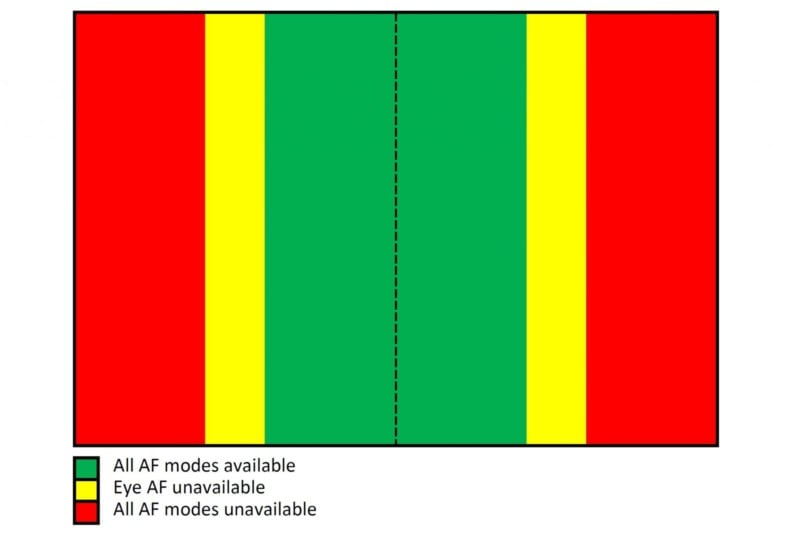
This reduction in AF area coverage on the adapted Canon 70-200mm f/2.8 can make focusing a problem when you’re using autofocus and the composition is away from the center of the frame. I don’t have any access to any other Canon to Sony autofocus adapters so I’m not sure if this change in performance is unique to the Sigma MC-11 adapter.
While discussing autofocus there is a quirk that I’ve noticed with the adapted Canon 70-200mm. The Canon lens has mechanical full-time manual focusing which works great on a Canon body, allowing you to override the AF. However, if you catch the focus ring on the Sony while pressing the AF button you can feel the focus motor grind and slip against the focus ring. I’m not sure if this will cause any long-term damage to the focus motor so it’s something that I think needs to be avoided
And the winner is… hands-down win for the Tamron with full AF tracking across the frame.
Focus Speed
Another of the key performance characteristics for me is the focus speed, it’s no good having an optically great lens if it takes too long to obtain sharp focus. This is especially important for documentary/reportage photographers who are trying to capture moments on the fly as they really happen.
For this test, I set the Sony a7 III on a tripod with the zoom of each lens at 70mm. The aperture was set to f/2.8 while each lens was focused on an object 1.2m away (this is the minimum focus distance of the Canon 70-200mm). I then moved the focus point to a high contrast object that was at infinity focus and half-pressed the camera shutter button using autofocus to lock on to the target. While this was being done I pressed a microphone right up against the lens barrel to record the sound of the lens focus motors. I then imported the audio files into Audacity and processed them to work out how long each lens took to focus.
Over several tests, the Canon 70-200mm f/2.8 posted times of between 0.2 to 0.25 seconds. Measuring accurate times on the Tamron lens proved somewhat more difficult due to two factors: the lens is incredibly fast and quiet. This made it hard to record the focus motor noise over even the slightest background sounds. As the focus motor noise is so short and quiet it’s very difficult to work out exact timings for the focus speed, but it’s blazingly fast… in the region of 0.04 seconds. It feels almost as fast to focus as a native Sony prime lens such as the Sony 24mm f/1.4 GM.
And the winner is… again another hands-down win for the Tamron with its incredible focus speed.
Flare
I’ve only done some very simple and quick testing of the flare handling of the two lenses. These tests were done shooting directly into the sun through a window with both lenses wide open at f/2.8 with the zoom at 70mm. I wanted to shoot through a window so that I could keep some of the frame dark so that any flare would hopefully show up better.
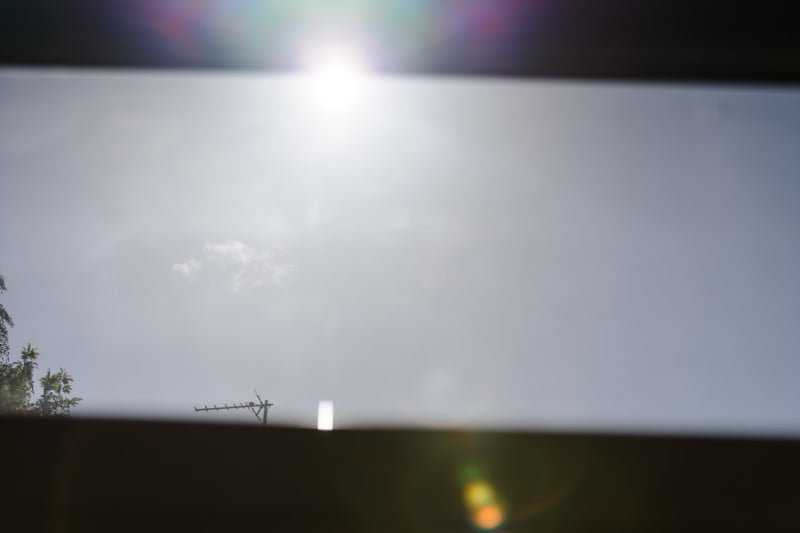
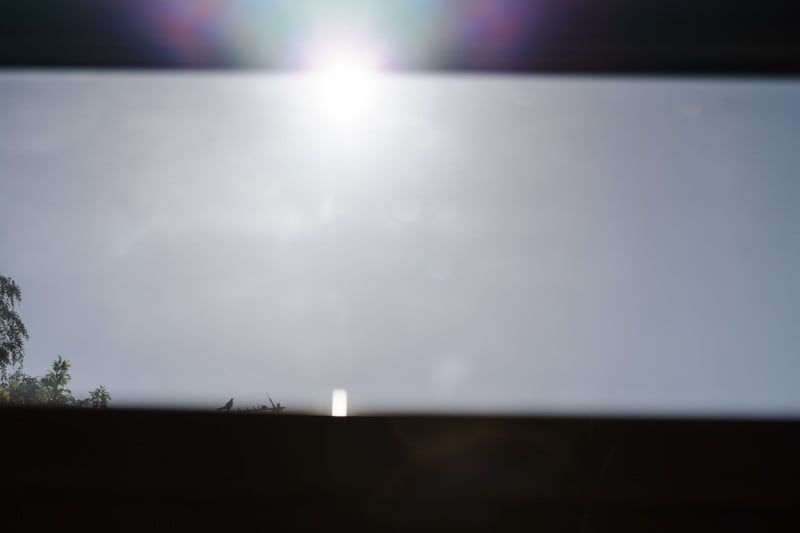
Not the most scintillating of photos but they do show that the Tamron is streets ahead of the Canon in terms of controlling flare. I’m not sure if the newer Mark III version of the Canon 70-200mm would fare any better, as according to reports, the only changes were to some lens coatings that may help with flare control.
And the winner is… The Tamron 70-180mm has much better flare control.
Construction
This is one area where there is a massive difference between the two lenses. The Canon 70-200mm is an internal zoom design, the lens body does not change length when zooming. However, the Tamron 70-180mm is a telescopic lens with a body that extends as it zooms towards 180mm.
One of the big advantages of the internal zoom design is the extra robustness that this gives. The Canon 70-200mm is beautifully engineered and built like a tank, with an all-metal exterior construction. This is good in one way as it means the lens has a very solid and robust feel, giving lots of confidence that it can take the odd knock. However, this robustness comes with a trade-off, it’s a very heavy lens (I’ll discuss this further in a later section specifically related to weight). The other main advantage of this type of lens design is that it makes weather sealing easier and more effective. Some people also claim that this type of design is less likely to suck dust inside the lens although I think this is clutching at straws a little.
The telescoping design of the Tamron has an external construction made from high-grade engineering plastic rather than metal. These factors help to give the Tamron lens a massive weight saving over the Canon, it’s about half the weight. The extending barrel feels well fitted to the static section and there’s no wobble or rattle anywhere along the travel. Although the Tamron is built from plastic it still feels very solid and well put together, but it’s not in the same league as the Canon.
And the winner is… A big win for the Canon, built like a tank!
Zoom Feel
The type of construction of the lens, internal zoom or telescoping, will have an impact on the zoom feel of the lens as it’s moved from wide-angle to telephoto. With an internal zoom, you’re only moving the zoom group lens elements, but with a telescoping lens, you’re also moving the extending section of the lens barrel.
The zoom feel on the Canon 70-200mm f/2.8 is super smooth and it has a nice light, low friction feel. When I’m shooting with this lens on the Sony a7 III I usually grip the lens foot in my left hand and can then operate the zoom by rolling my thumb across the zoom ring. Although the zoom is action is very smooth there is a small amount of backlash when changing direction.
The Tamron 70-180mm f/2.8 Di III VXD has a slightly heavier zoom feel and there’s also a little more stiction to overcome to get the lens moving. This extra friction means that the Tamron zoom feel is a little stiffer and requires more of a grip between the finger and thumb on the zoom ring for it to operate. I’m not saying that the zoom feel of the Tamron lens is bad, far from it. It feels just fine for a telescoping zoom lens. It’s just that it’s not as effortless as the Canon.
Another difference between how the two lenses can feel during zooming is the positioning of the zoom rings. On the Canon EF 70-200mm f/2.8L IS II USM the zoom ring is positioned closest to the camera body and the focus ring is at the far end of the lens. On the Tamron 70-180mm f/2.8 Di III VXD, they are the opposite way round, with the zoom ring at the far end of the lens and the focus ring closer to the body (this positioning matches the other Tamron zoom lenses). There’s no right and wrong way to do this but traditionally lenses have had their zoom rings closest to the camera body so it can be a little disorientating at first when you use the Tamron.
And the winner is… A marginal win for the Canon with its silky smooth zoom feel.
Switches / Functions
The Canon lens features 4 function switches: a focus range limiter, an AF/MF selector, one for turning the stabilizer on/off, and a stabilizer mode switch. Although switches are often handy to have I never really used the ones on the Canon EF 70-200mm f/2.8L IS II USM as I don’t really utilize the functions that are mapped to them. Occasionally switches can be accidentally moved from their default position when the camera is hanging from a strap and this can cause problems. The Canon 85mm f/1.4 IS was always problematic with an IS switch which was way too proud of the body and required taping down to prevent accidental switching.
The Canon lens also features a small window on the top of the lens with a distance scale indicator. I can hold my hands in the air and state that in all honesty, in 7 years of owning the lens, I’ve never used or looked at it once. A completely redundant feature!
The only switch present on the Tamron lens is a zoom lock switch which can only be used at 70mm. When locked it stops the lens extending when hanging vertically down on a strap. It’s a bit of a shame that the switch only works at 70mm as it would be hand to be able to lock it off at any point in the zoom range. The absence of any function switches on the Tamron lens doesn’t bother me as I have all the functions I need mapped onto buttons on the camera body.
And the winner is… The Canon has more switches (although unused by me) so I guess it’s another Canon win.
Weight
Rather than use the weight measurements from the manufacturers’ websites, I took measurements using my own scales. This was done to ensure that the lenses were in the state in which I use them i.e. without the hood and lens caps attached.
The all-metal construction of the Canon EF 70-200mm f/2.8L IS II USM means that it’s a very heavy lens, weighing in on my scales at 1608g. When using it on a Sony body you also need to factor in the weight of the adapter. The Sigma MC-11 adds a further 125g to the weight, bringing the total up to 1732g (you can save 118g by removing the tripod collar).
The weight is problematic for me, the lens is just too heavy to use for extended periods of time. Even when I was shooting with my old Canon 5D bodies it felt a little front heavy and unbalanced, this effect is magnified on the much lighter a7 III body with its smaller grip. The turning moment generated by the lens on the Sony body really does pull on your hand and wrist making it uncomfortable to hold. You have to adjust your normal handgrip so that you’re holding the lens rather than the camera body, this can make turning the zoom ring a little more awkward.
The Tamron 70-180mm f/2.8 Di III VXD (A056) is much lighter, less than half the weight, tipping the scales at 804g. This is a massive weight saving and makes using the lens much more comfortable. The camera can be gripped in the usual way making operating everything feel a little more normal. The other big factor in the weight saving is how much lighter it makes your camera bag, the Tamron saves 928g when you factor in the lens and adapter.
It’s not just the body construction and materials which give the big weight saving on the Tamron, there is also less glass in the lens. The data sheets show that the Tamron has 19 elements in 14 groups and the Canon 23 elements in 19 groups.
And the winner is… a big win for the Tamron with its weight saving of over 50%.
Size
Rather than take the length measurements from the manufacturers’ websites, I took my own measurements. I wanted to ensure that the lengths were measured in the same way on both lenses. The measurements were taken from the front-most protrusion of the lens body to the lens mount flange and not including the internal bayonet.
The Canon EF 70-200mm f/2.8L IS II USM has a length of 200mm, but you also need to add on the 25mm for the Sigma MC-11 adapter. This brings the total length to 225mm. The Tamron 70-180mm f/2.8 Di III VXD is 26% shorter when at 70mm focal length as the lens is 147mm long.
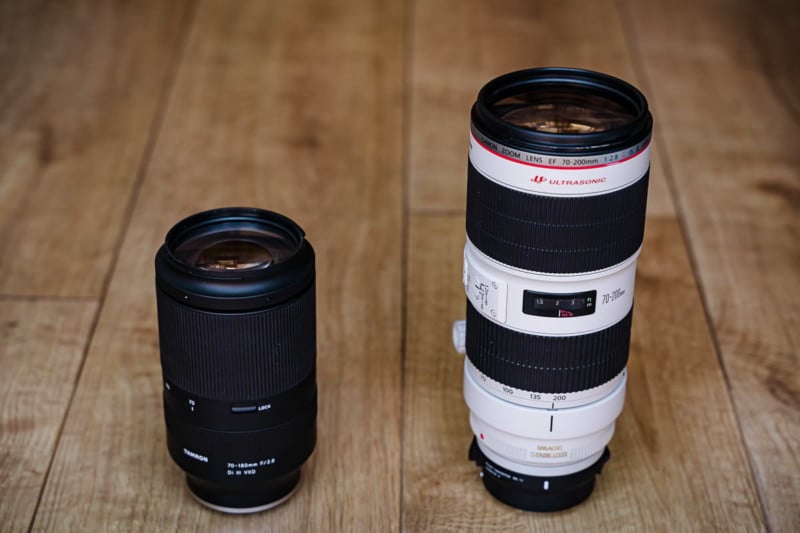
When fully extended at the 180mm the length of the Tamron increases by 30mm to 177mm long. However, it’s still significantly shorter than the 225mm of the Canon lens and Sigma adapter.

This is a big plus for the Tamron with the shorter length, especially at 70mm, giving much more packing space in the camera bag.
In terms of diameter, the Tamron is also smaller and uses a 67mm front filter (which is the same as the other Tamron zooms), where the Canon has a 77mm filter thread. As well as being smaller diameter the smaller thread makes any filters for the Tamron cheaper.
And the winner is… a big win for the small Tamron.
Image Stabilisation
The two lenses use different methods for image stabilization. When the Canon EF 70-200mm f/2.8L IS II USM is mounted on the Sony a7 III the system is only utilizing the IS within the lens itself and the IBIS system in the camera body is disabled (the SteadyShot option within menu 2 page 4 is set to off and greyed out so that the setting can’t be changed). The Tamron 70-180mm f/2.8 Di III VXD doesn’t contain any in-lens stabilization and relies entirely on the IBIS system within the camera body. I was really curious to find out which system would work best. It’s often stated online that in-lens IS works better than IBIS at longer focal lengths. However, there is a significant weight difference between the lenses which could also impact the results.
It’s hard to do an accurate, quantifiable, and repeatable image stabilization test. Although probably not a perfect method, the best I can come up with is to shoot a static target while hand holding the camera at differing shutter speeds.
To make the test as extreme as possible I set each lens at its maximum focal length in order to magnify any unintentional movement of the camera. This does give a slight advantage to the Tamron lens with its slightly shorter focal length of 180mm. I then set a target (a biscuit tin lid with a very detailed pattern!) very close to the camera, at 1.8 meters, again so that any movement of the camera would be more noticeable. With the lens wide open I took a series of individual shots (not burst mode) at 1/200s. I then reduced the shutter speed in one stop intervals and took a series of shots at each interval, repeating until I could no longer obtain blur-free images. All the shots were taken trying to utilize my best sniper breathing techniques in an attempt to minimize the camera movement. The files were then bought into Lightroom and viewed at a 4:1 magnification on a 4k screen and evaluated. I then looked to see what percentage of images were tack sharp and motion free.

The results of the testing are summarised in the table below.
![]()
The results from the testing show that the Canon, with its lens-based IS system, has a clear advantage over the Tamron, which utilizes the in body IBIS system of the a7 III.
Note that this is a very extreme test, the shots were taken at the maximum focal length of the lens with a target only 1.8m away and I was being very critical when looking for any movement in the files.
And the winner is… The Canon, the in-lens IS system beats the IBIS method used on the Tamron.
Price
The US launch price for the Tamron 70-180mm f/2.8 Di III VXD is $1,199. I’m hoping to sell my Canon EF 70-200mm f/2.8L IS II USM for around that much, making the purchase price neutral.
One of the things that I’m acutely aware of is the move by Canon from the EF to the mirrorless RF mount. I think this will have a big impact on prices for used EF lenses going forward. Canon users are likely to migrate to the new RF mount and it could potentially drive the prices of EF-mount lenses down as users would prefer a native RF mount lens.
And the winner is… No real winner here, it’s about trying to maximize the sale price of the Canon EF 70-200mm f/2.8L IS II USM to make the purchase of the Tamron 70-180mm f/2.8 Di III VXD as price neutral as possible.
Macro Capabilities
Although not touted as a macro lens it’s still possible to get some good closeup shots with the Canon 70-200mm f/2.8. It has a minimum focus distance of 1.2 meters. With the zoom at 200mm, you can get a decent shot of small items such, providing you have enough room!
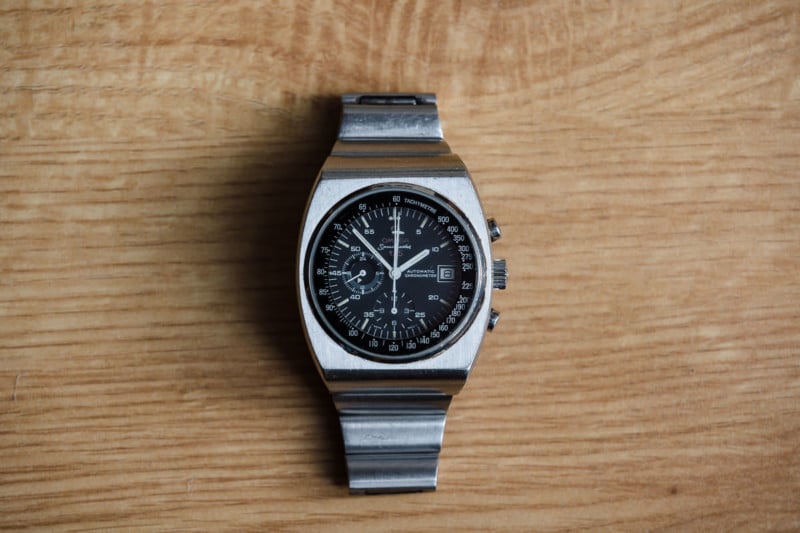
One of the little shouted about features of the Tamron 70-180mm f/2.8 Di III VXD is its use as a macro lens. When using the AF mode the minimum focus distance is a little closer than the Canon at 0.85m.
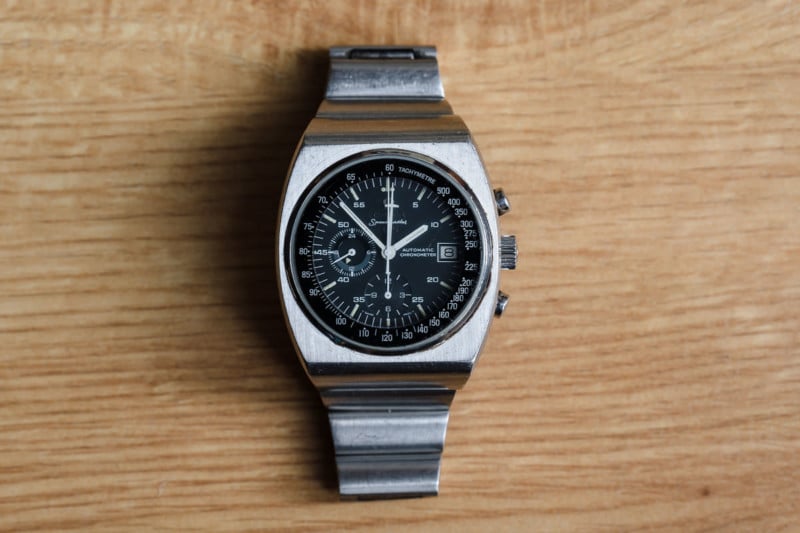
However, if you switch to manual focus and rack the zoom back to 70mm then the minimum focus distance falls to 0.27m. This gives a magnification ratio of 1:2
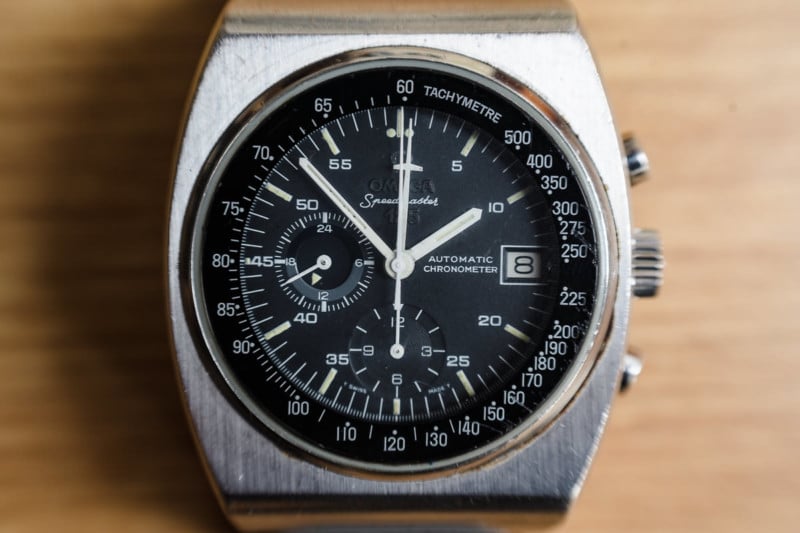
Tamron advises using only the center of the frame for your in-focus area as there is stretching (lateral/radial blur) at the periphery of the frame.
I very occasionally use a macro lens, an adapted Canon EF 100mm f/2.8 Macro USM, which I use for the odd ring shot at weddings.

I’ll do some further testing looking at the macro capabilities of the Tamron 70-180mm to see if it will allow me to replace and get rid of my old Canon macro lens. This would be great, generating a little bit more cash and taking some more weight out of my camera bag.
And the winner is… The Tamron, it has closer AF and an insanely close manual focus range.
Reliability
As I mentioned at the start of this article, one of the biggest problems I’ve had using the Canon 70-200mm f/2.8L IS II USM with the Sigma MC-11 on the Sony a7 III is that I occasionally get a lock-up. It usually happens once nearly every time I use the setup. When this happens, the only way to get the camera working again is to turn it off and pull the battery out, making sure the buffer has cleared first! This can be a massive issue when photographing events that can’t really be repeated, such as the entrance of the bride at a wedding or the first kiss. This means that I’m not fully confident in my setup when using the adapted lens.
It’s very early days with the Tamron but I’ve had zero issues so far. There have been no compatibility issues, no freezing and no lockups of the camera. I’ll update the blog post if there are any problems down the line.
And the winner is… Tamron at this early stage.
Miscellaneous
I’ve included below a few other miscellaneous points that are worth mentioning…
One of the big advantages of using a native mount lens is not having to use an adapter. An adapter introduces another set of interfaces / potential failure points. Additionally, the Sigma MC-11 adapter is not weather-sealed, so shooting in inclement weather is not advised. The flap on the software update socket on the MC-11 in particular looks like a weak point.
Sony has a fairly big stake in Tamron and I think this plays a large part in ensuring there is full functionality of all the standard features when a Tamron lens is fitted. All the focusing modes work as well as native glass but also there is in-camera correction for shading, chromatic aberration, and distortion. You can also use the camera to perform firmware updates for the lens. If there are any further firmware updates for the Canon 70-200mm f/2.8L IS II USM then these could be problematic for me to perform as I no longer have any Canon bodies to enable me to update the lens firmware.
There’s a certain cachet to be had when using one of the big white Canon L series lenses with the red ring, they certainly attract knowing looks from other camera users. Although any 70-200mm lens would struggle to be called discrete, the big white Canon zoom certainly does attract attention whenever it is pulled out from the camera bag. This can be a big disadvantage if you’re trying to be discrete or shooting for natural/candid moments. The much smaller and more discretely colored Tamron 70-180mm should hopefully enable some more stealthy shooting.
It’s interesting to note that the new Canon RF 70-200mm f/2.8L IS USM for their new mirrorless RF mount cameras also adopts a telescoping design. This gives it a more compact and lightweight design compared to the Canon EF 70-200mm f/2.8L IS II USM. The RF 70-200mm weighs in at 1070g but costs a whopping £2599 (Amazon UK price as of July 2020).
Sample Images
I have no real-world wedding images to share yet so here are some pictures of my daughter running about and climbing some trees!
![]()
![]()
![]()
![]()
![]()
Conclusion
Is the switch to the new Tamron 70-180mm f/2.8 worth it if you’re using an adapted Canon 70-200mm f/2.8? Here’s a quick summary of the strengths of each lens.
![]()
For me, it’s a resounding yes. I’m actually really surprised by the sharpness and bokeh test results of the Tamron 70-180mm. Somehow Tamron has been able to match the optical quality (and in some cases exceed it) of the big Canon zoom with a lighter, smaller lens that has fewer glass elements. The AF speed is incredibly fast and gives coverage over the entire frame. The only real downside is the reduction of build quality/robustness of the Tamron. However, that is offset by that incredible weight reduction which would not be possible without the build changes implemented.
If you mainly shoot zooms, you might want to stick with the Canon for the extra robustness or switch to the Sony equivalent if you want the extra robustness and improved native lens AF performance. However, for me, I’m more than willing to sacrifice a little of the robustness of the Canon 70-200mm for all of the advantages that the Tamron 70-180mm brings.
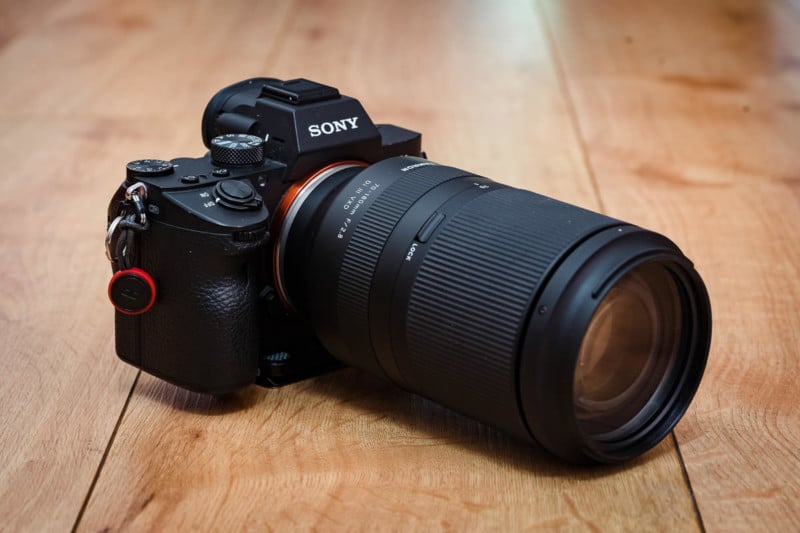
The real test for me will be how well this works in the wedding environment. Due to the ongoing coronavirus / COVID-19 situation weddings aren’t properly up and running in the UK yet.
About the author: Simon Brettell is an award-winning documentary wedding photographer based in the city of Birmingham in the West Midlands in England. The opinions expressed in this article are solely those of the author. You can find more of Brettell’s work on his website. This article was also published here.